Antibody SC27 developed in part by Associate Professor based at Texas Biomedical Research Institute
SAN ANTONIO, Sept. 5, 2024 /PRNewswire/ -- A discovery led in part by a Texas Biomedical Research Institute (Texas Biomed) Associate Professor has opened the possibility of large-scale manufacturing of broader, more effective COVID treatments.
The monoclonal antibody appears effective at neutralizing the numerous variants of SARS-CoV-2, as well as related viruses in animals that could pose a threat if they were to begin spreading in people. The antibody, named SC27, was recently described in the peer-reviewed Cell Reports Medicine.
The finding opens the possibility of more effective treatments to work against COVID-19 variants and related coronaviruses – including past, present and potential future strains.
Monoclonal antibody SC27 was identified, developed and provisionally patented by a team of researchers led by Greg Ippolito, Ph.D., Associate Professor at Texas Biomed. Other team leaders included Jason Lavinder, Ph.D., at University of Texas (UT) at Austin, and Ralph Baric, Ph.D., at University of North Carolina at Chapel Hill.
Texas Biomed is the nation’s only nonprofit, independent research institute with the highest-level biocontainment laboratories, a national primate research center and over 80 years of experience. Scientists at the 200-acre campus in San Antonio collaborate with academic institutes, the military, pharmaceutical companies, the National Institutes of Health and biotech start-ups.
Dr. Ippolito explained that antibody SC27 appears to offer a more sophisticated treatment approach.
“Other COVID-19 antibodies have been rendered ineffective as SARS-CoV-2 has evolved over the past several years,” said Dr. Ippolito, who was recently recruited to Texas Biomed from UT. “Our new study suggests the virus is less likely to escape this treatment because SC27 targets and attaches to multiple parts of the virus’s spike protein, including sections that are not mutating as frequently.”
SC27 appears to work in two ways: it blocks the ACE2 binding site, which the virus uses to bind to, enter and infect cells. It also binds to a hidden or “cryptic” site on the underside of the spike protein that is largely unchanged or “conserved” between variants, which means SC27 can broadly recognize variants and related viruses. This is critical because if an antibody’s shape does not match enough with a virus – like two puzzle pieces that don’t quite fit – the antibody can’t effectively neutralize the virus and the virus sneaks by the body’s immune defense system.
The researchers tested SC27 against 12 viruses, from the original SARS-CoV-2 to currently circulating variants, as well as related SARS-1 and several other coronaviruses found in bats and pangolins. The antibody was effective against all of them in a petri dish and protected mice against both variants tested.
The team is looking to collaborate with industry to further develop the SC27 monoclonal antibody treatment, which could potentially benefit immunocompromised patients who are unable to get vaccines. It also could serve as an emergency treatment during future outbreaks of new variants or coronaviruses. Next steps would include preclinical studies in larger animal models.
Notably, SC27 was found in individuals following vaccination with mRNA COVID-19 vaccines. Previously, this type of “class 1/4" antibody – which attaches to two distinct areas or “epitopes” of the spike protein – was only detected following natural infection from SARS-1.
“This is fantastic news that vaccines can prompt the generation of these more robust and effective antibodies,” explained Dr. Ippolito. “It means that future vaccine development can be tailored to generate these antibodies and have a clear metric for measuring which vaccines will be most effective.”
![]() View original content to download multimedia:https://www.prnewswire.com/news-releases/monoclonal-antibody-shows-protection-against-all-covid-variants-302239958.html
View original content to download multimedia:https://www.prnewswire.com/news-releases/monoclonal-antibody-shows-protection-against-all-covid-variants-302239958.html
SOURCE Texas Biomedical Research Institute






